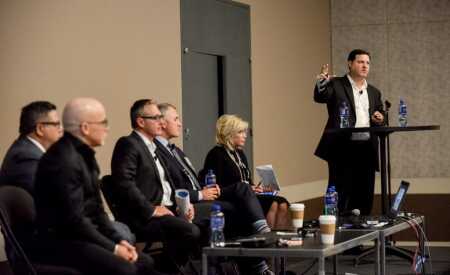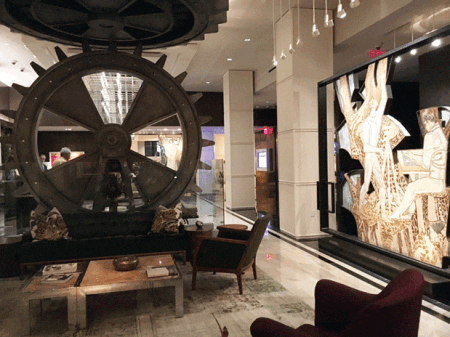From dramatic outdoor sculptures, such as a 30-foot (9 m) eyeball, to a Baccarat crystal–themed design, hotel and resort developers are coming up with new ways to create allure in urban locations—where they can’t rely on beaches, golf, or skiing to attract fickle travelers.
“Airbnb is on track to become the world’s biggest hotel business; if this doesn’t scare hotel and resort owners, nothing will,” said Toni Alexander of InterCommunicationsInc, moderating a hospitality session at ULI’s 2016 Fall Meeting in Dallas. “Thirty-one percent of Airbnb customers have used this service for business travel, and Airbnb is now targeting this profitable segment.
“Last year’s buzz was destination resorts, but now the industry is moving into cities,” she went on. “We are focusing on urban exploration and connection, trading bars for culinary kitchens, converting rooftop lounges to urban glamping adventures, all to attract the creative class and more.”
This trend is happening because work and leisure lives are becoming blurred, posited Scott Lee of SB Architects. “People need a break from the 24/7 lifestyle, so we are seeking urban adventure and cultural exploration,” he said. Urban brands are getting into resort locations, and resort brands are migrating to urban settings, creating new, highly amenitized urban resort models that blend leisure and business in gateway cities.
These new urban resorts, according to Lee, provide a variety of features including an immersive experience, sense of retreat, indoor-outdoor space, connection to nature, natural light, out-of-the-box design, iconic food and beverage service, rooftop everything, and a dedication to health, wellness, and sustainability. Prime examples include the Park Hyatt Los Cabos; Auberge Urban resorts; 1 Hotels in various cities; the planned Mandarin Oriental in Boca Raton, Florida; and no less than three in Miami: the Delano, the Setai, and East, Miami, which is located atop the new Brickell City Center.
Sometimes, an urban resort’s appeal is based in its glamorous history. Entrepreneur Beny Alagem acquired the storied Beverly Hilton in Los Angeles in 2003 from longtime owner Merv Griffin. The hotel had opened in 1953 as a Hilton flagship, and much of its nine-acre (3.6 ha) site was devoted to parking. Alagem put nearly $100 million into renovating the existing building.
In April 2006, the ownership proposed a $500 million expansion that would include a new Waldorf-Astoria hotel, condos, and green space. “The goal was to create an oasis, capitalize on the hotel’s rich cultural history, be a good neighbor, and create a timeless international destination as well as a legacy for the ownership,” explained Steven Upchurch, a principal and Gensler’s hospitality practice leader. The expansion’s $200 million Phase I is nearing completion with the 2017 opening of the new 12-story, 170-key Waldorf-Astoria Beverly Hills. At the same time, the ownership is seeking further entitlements to consolidate the approved condos into a single 375-foot (114 m) tower while creating a two-acre (0.8 ha) park along Wilshire Boulevard. “This is the new vision of urbanization: compact, dense, walkable, resilient, and sustainable,” said Upchurch.
Bling and a big brand combine to create glittery opulence at the new Baccarat Hotel in New York City’s midtown. “Clients often say they want something new, but this was different,” said Brant E. Coletta, a managing partner with Skidmore, Owings & Merrill, the project architect. “The client showed up with a Baccarat crystal object, saying: ‘I want this to be my new brand.’ ” With a dark mid-block location and the need to incorporate a rebuilt New York City library, an international design team faced major challenges in creating what Forbes magazine called a “crystal palace.”
But developer Barry Sternlicht’s bet paid off: before a single guest had checked in, a Chinese insurance firm snapped up the hotel (which is topped with luxury condos, including a $60 million penthouse) for a record $2 million per key.
And speaking of bets: casinos can still be the focus for successful new resorts. “Casinos are here to stay,” commented Nunzio DeSantis of HKS Hospitality Group, which is building the $1.4 billion MGM National Harbor in suburban Washington, D.C. Set to open in early December, this megacomplex includes a 300-room hotel, a 3,000-seat theater, a conference center, multiple dining options, a flower-filled conservatory ringed with shops and restaurants, and an expansive casino.
But bigger isn’t always best. The Joule is a jewel in the heart of Dallas, replacing decaying and abandoned buildings with “a social urban environment where people can experience things they can’t find anywhere else in Texas,” explained Michael Tregoning, chief executive of the Headington Companies. This boutique hotel opened in 2003 in what had been an abandoned 1930s neo-Gothic building. Since then, the developer/owner has acquired more than 15 additional buildings in the area, to expand the hotel’s room count and amenities. The Joule’s main lobby features restored mosaics saved from one demolished historic building, as well as museum-quality art. “Art to match the couch does not happen here,” Tregoning said.
The Joule offers on-site restaurants and shops, a rooftop event space, a cantilevered swimming pool, a fitness studio, an 8,000-square-foot subterranean spa, a bookstore with carefully curated tomes, and a terrace overlooking the 30-foot (9 m) Eye sculpture by Tony Tasset installed across from the main hotel in 2013. Tregoning seems to have found a way to nail the goal embraced by many urban hotel and resort developers: “Our brand is being social.”


